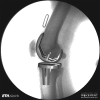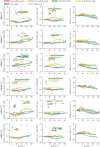Knee implant kinematics are task-dependent
- PMID: 30958178
- PMCID: PMC6408358
- DOI: 10.1098/rsif.2018.0678
Knee implant kinematics are task-dependent
Abstract
Although total knee arthroplasty (TKA) has become a standard surgical procedure for relieving pain, knowledge of the in vivo knee joint kinematics throughout common functional activities of daily living is still missing. The goal of this study was to analyse knee joint motion throughout complete cycles of daily activities in TKA subjects to establish whether a significant difference in joint kinematics occurs between different activities. Using dynamic videofluoroscopy, we assessed tibio-femoral kinematics in six subjects throughout complete cycles of walking, stair descent, sit-to-stand and stand-to-sit. The mean range of condylar anterior-posterior translation exhibited clear task dependency across all subjects. A significantly larger anterior-posterior translation was observed during stair descent compared to level walking and stand-to-sit. Local minima were observed at approximately 30° flexion for different tasks, which were more prominent during loaded task phases. This characteristic is likely to correspond to the specific design of the implant. From the data presented in this study, it is clear that the flexion angle alone cannot fully explain tibio-femoral implant kinematics. As a result, it seems that the assessment of complete cycles of the most frequent functional activities is imperative when evaluating the behaviour of a TKA design in vivo.
Keywords: activities of daily living; gait activities; moving fluoroscope; tibio-femoral kinematics; total knee arthroplasty; videofluoroscopy.
Conflict of interest statement
R.L. has received speaker's fees from Medacta and DePuy Synthes. R.L. has received research funding from DePuy Synthes and Medacta International.
Figures







References
Publication types
MeSH terms
LinkOut - more resources
Full Text Sources
Medical
Research Materials

